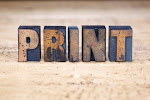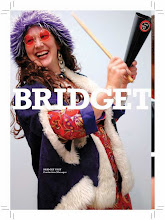This particular installment is for folks JUST getting into print production. A little lesson on print jargon, most of it straight from the folks at Mohawk, Wikipedia, and About.com.
In 2007, Mohawk put out a little flip book called Vital Information. I have used that item as a resource since (especially when I'm proofing and the age-old em and en dashes vs. hyphens issue comes up!). As I perused the book, I ran across some press lingo that's widely used. Knowing the vernacular will give beginners a leg-up when dealing with print vendors.
Plate: Printing processes such as offset lithography (see definition below) use printing plates to transfer an image to paper or other substrates. The plates may be made of metal, plastic, rubber, paper, or other materials. The image is put on the printing plates using photomechanical, photochemical, or laser engraving processes. See image below for an example of a typical plate, printed on metal (or aluminum).

Typically, printing plates are attached to a cylinder in the press. Ink is applied to the plate's image area and transferred directly to the paper or to an intermediary cylinder and then to the paper. The printing plates used depends on the type of press, the printing method, and quantity of the print run. A plate is prepared for each color used, or four plates in the case of 4-color (CMYK) process printing.

Sheet-fed: Method of printing on sheets of paper. See image below.

Parent Sized Sheet: Most mills offer their paper in "parent-sized" sheets. A typical parent sized sheet is approximately 35" x 23" or 35" x 40." These are the sheets the offset presses typically use. Your print vendor's pre-press team will figure out how to layout your design on the parent sheets of the paper you specify.
Gripper Edge: The leading edge of the paper as it passes through a printing press.
Sheetwise: To print one side of paper with one set of plates, then turn the sheet over and print the other side with another set of plates, using the same gripper and side guide.
Web: A method of printing on rolls of paper (vs. parent sized sheets). This method is typically used on items that require you to print large quantities (100K+). See image below for an example of a web press.

Hope this basic lesson in press jargon was helpful. Now, print with confidence!
b





I enjoy reading your blog,I'm working in one printing press in California and we offer high quality printing service.
ReplyDelete